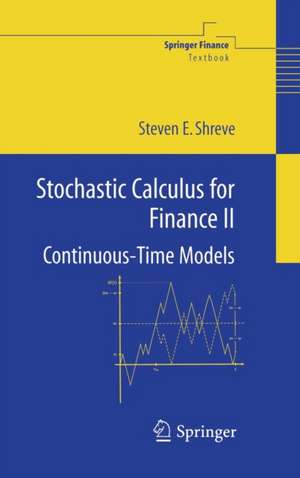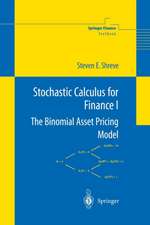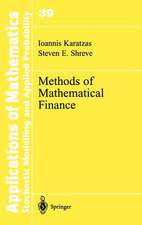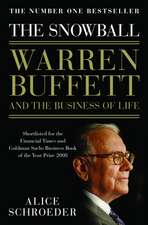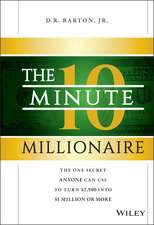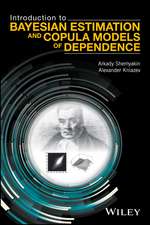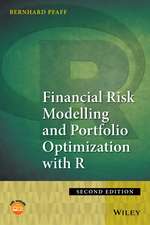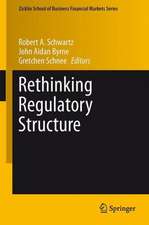Stochastic Calculus for Finance II: Continuous-Time Models: Springer Finance
Autor Steven Shreveen Limba Engleză Hardback – 3 iun 2004
| Toate formatele și edițiile | Preț | Express |
|---|---|---|
| Paperback (1) | 366.05 lei 3-5 săpt. | +33.13 lei 6-12 zile |
| Springer – dec 2010 | 366.05 lei 3-5 săpt. | +33.13 lei 6-12 zile |
| Hardback (1) | 359.68 lei 3-5 săpt. | +40.98 lei 6-12 zile |
| Springer – 3 iun 2004 | 359.68 lei 3-5 săpt. | +40.98 lei 6-12 zile |
Din seria Springer Finance
- 24%
 Preț: 703.48 lei
Preț: 703.48 lei - 18%
 Preț: 787.15 lei
Preț: 787.15 lei - 19%
 Preț: 501.57 lei
Preț: 501.57 lei - 24%
 Preț: 809.78 lei
Preț: 809.78 lei - 17%
 Preț: 361.17 lei
Preț: 361.17 lei - 24%
 Preț: 605.31 lei
Preț: 605.31 lei - 17%
 Preț: 398.82 lei
Preț: 398.82 lei - 15%
 Preț: 649.06 lei
Preț: 649.06 lei - 18%
 Preț: 937.37 lei
Preț: 937.37 lei - 15%
 Preț: 659.85 lei
Preț: 659.85 lei - 18%
 Preț: 801.17 lei
Preț: 801.17 lei -
 Preț: 387.75 lei
Preț: 387.75 lei - 18%
 Preț: 1108.36 lei
Preț: 1108.36 lei - 15%
 Preț: 651.19 lei
Preț: 651.19 lei - 15%
 Preț: 658.88 lei
Preț: 658.88 lei - 18%
 Preț: 1112.60 lei
Preț: 1112.60 lei - 18%
 Preț: 937.86 lei
Preț: 937.86 lei -
 Preț: 418.34 lei
Preț: 418.34 lei -
 Preț: 398.15 lei
Preț: 398.15 lei - 15%
 Preț: 597.01 lei
Preț: 597.01 lei - 15%
 Preț: 637.89 lei
Preț: 637.89 lei - 18%
 Preț: 939.62 lei
Preț: 939.62 lei - 15%
 Preț: 632.19 lei
Preț: 632.19 lei - 18%
 Preț: 737.26 lei
Preț: 737.26 lei -
 Preț: 385.84 lei
Preț: 385.84 lei - 18%
 Preț: 892.90 lei
Preț: 892.90 lei -
 Preț: 395.25 lei
Preț: 395.25 lei - 15%
 Preț: 497.45 lei
Preț: 497.45 lei - 15%
 Preț: 644.95 lei
Preț: 644.95 lei - 18%
 Preț: 1207.45 lei
Preț: 1207.45 lei - 18%
 Preț: 810.81 lei
Preț: 810.81 lei -
 Preț: 391.61 lei
Preț: 391.61 lei - 19%
 Preț: 506.25 lei
Preț: 506.25 lei - 18%
 Preț: 957.62 lei
Preț: 957.62 lei -
 Preț: 387.75 lei
Preț: 387.75 lei - 15%
 Preț: 503.37 lei
Preț: 503.37 lei - 15%
 Preț: 593.91 lei
Preț: 593.91 lei -
 Preț: 383.71 lei
Preț: 383.71 lei
Preț: 359.68 lei
Preț vechi: 413.42 lei
-13% Nou
68.83€ • 73.60$ • 57.38£
Carte disponibilă
Livrare economică 27 martie-10 aprilie
Livrare express 12-18 martie pentru 50.97 lei
Specificații
ISBN-10: 0387401016
Pagini: 572
Ilustrații: XIX, 550 p.
Dimensiuni: 155 x 235 x 38 mm
Greutate: 0.95 kg
Ediția:2004
Editura: Springer
Colecția Springer
Seria Springer Finance
Locul publicării:New York, NY, United States
Public țintă
ResearchCuprins
1 General Probability Theory1.1 In.nite Probability Spaces1.2 Random Variables and Distributions1.3 Expectations1.4 Convergence of Integrals1.5 Computation of Expectations1.6 Change of Measure1.7 Summary1.8 Notes1.9 Exercises 2 Information and Conditioning2.1 Information and s-algebras2.2 Independence2.3 General Conditional Expectations2.4 Summary2.5 Notes2.6 Exercises 3 Brownian Motion3.1 Introduction3.2 Scaled Random Walks3.2.1 Symmetric Random Walk3.2.2 Increments of Symmetric Random Walk3.2.3 Martingale Property for Symmetric Random Walk3.2.4 Quadratic Variation of Symmetric Random Walk3.2.5 Scaled Symmetric Random Walk3.2.6 Limiting Distribution of Scaled Random Walk3.2.7 Log-Normal Distribution as Limit of Binomial Model3.3 Brownian Motion3.3.1 Definition of Brownian Motion3.3.2 Distribution of Brownian Motion3.3.3 Filtration for Brownian Motion3.3.4 Martingale Property for Brownian Motion3.4 Quadratic Variation3.4.1 First-Order Variation3.4.2 Quadratic Variation3.4.3 Volatility of Geometric Brownian Motion3.5 Markov Property3.6 First Passage Time Distribution3.7 Re.ection Principle3.7.1 Reflection Equality3.7.2 First Passage Time Distribution3.7.3 Distribution of Brownian Motion and Its Maximum3.8 Summary3.9 Notes3.10 Exercises 4 Stochastic Calculus4.1 Introduction4.2 Itˆo's Integral for Simple Integrands4.2.1 Construction of the Integral4.2.2 Properties of the Integral4.3 Itˆo's Integral for General Integrands4.4 Itˆo-Doeblin Formula4.4.1 Formula for Brownian Motion4.4.2 Formula for Itˆo Processes4.4.3 Examples4.5 Black-Scholes-Merton Equation4.5.1 Evolution of Portfolio Value4.5.2 Evolution of Option Value4.5.3 Equating the Evolutions4.5.4 Solution to the Black-Scholes-Merton Equation4.5.5 TheGreeks4.5.6 Put-Call Parity4.6 Multivariable Stochastic Calculus4.6.1 Multiple Brownian Motions4.6.2 Itˆo-Doeblin Formula for Multiple Processes4.6.3 Recognizing a Brownian Motion4.7 Brownian Bridge4.7.1 Gaussian Processes4.7.2 Brownian Bridge as a Gaussian Process4.7.3 Brownian Bridge as a Scaled Stochastic Integral4.7.4 Multidimensional Distribution of Brownian Bridge4.7.5 Brownian Bridge as Conditioned Brownian Motion4.8 Summary4.9 Notes4.10 Exercises 5 Risk-Neutral Pricing5.1 Introduction 5.2 Risk-Neutral Measure 5.2.1 Girsanov's Theorem for a Single Brownian Motion 5.2.2 Stock Under the Risk-Neutral Measure 5.2.3 Value of Portfolio Process Under the Risk-Neutral Measure 5.2.4 Pricing Under the Risk-Neutral Measure 5.2.5 Deriving the Black-Scholes-Merton Formula 5.3 Martingale Representation Theorem 5.3.1 Martingale Representation with One Brownian Motion5.3.2 Hedging with One Stock 5.4 Fundamental Theorems of Asset Pricing 5.4.1 Girsanov and Martingale Representation Theorems 5.4.2 Multidimensional Market Model 5.4.3 Existence of Risk-Neutral Measure5.4.4 Uniqueness of the Risk-Neutral Measure 5.5 Dividend-Paying Stocks 5.5.1 Continuously Paying Dividend 5.5.2 Continuously Paying Dividend with Constant Coeffcients 5.5.3 Lump Payments of Dividends 5.5.4 Lump Payments of Dividends with Constant Coeffcients5.6 Forwards and Futures 5.6.1 Forward Contracts5.6.2 Futures Contracts 5.6.3 Forward-Futures Spread 5.7 Summary 5.8 Notes 5.9 Exercises 6 Connections with Partial Differential Equations 6.1 Introduction 6.2 Stochastic Differential Equations 6.3 The Markov Property 6.4 Partial Differential Equations 6.5 Interest Rate Models 6.6 Multidimensional Feynman-Kac Theorems 6.7 Summary 6.8 Notes 6.9 Exercises 7 Exotic Options 7.1 Introduction
Recenzii
"Steven Shreve’s comprehensive two-volume Stochastic Calculus for Finance may well be the last word, at least for a while, in the flood of Master’s level books.... a detailed and authoritative reference for "quants” (formerly known as "rocket scientists”). The books are derived from lecture notes that have been available on the Web for years and that have developed a huge cult following among students, instructors, and practitioners. The key ideas presented in these works involve the mathematical theory of securities pricing based upon the ideas of classical finance.
...the beauty of mathematics is partly in the fact that it is self-contained and allows us to explore the logical implications of our hypotheses. The material of this volume of Shreve’s text is a wonderful display of the use of mathematical probability to derive a large set of results from a small set of assumptions.
In summary, this is a well-written text that treats the key classical models of finance through an applied probability approach. It is accessible to a broad audience and has been developed after years of teaching the subject. It should serve as an excellent introduction for anyone studying the mathematics of the classical theory of finance." (SIAM, 2005)
"The contents of the book have been used successfully with students whose mathematics background consists of calculus and calculus-based probability. The text gives both precise Statements of results, plausibility arguments, and even some proofs. But more importantly, intuitive explanations, developed and refine through classroom experience with this material are provided throughout the book." (Finanz Betrieb, 7:5, 2005)
"The origin of this two volume textbook are the well-known lecture notes on Stochastic Calculus … . The first volume contains the binomial asset pricing model. … The second volume covers continuous-time models … . This book continues the series of publications by Steven Shreve of highest quality on the one hand and accessibility on the other end. It is a must for anybody who wants to get into mathematical finance and a pleasure for experts … ." (www.mathfinance.de, 2004)
"This is the latter of the two-volume series evolving from the author’s mathematics courses in M.Sc. Computational Finance program at Carnegie Mellon University (USA). The content of this book is organized such as to give the reader precise statements of results, plausibility arguments, mathematical proofs and, more importantly, the intuitive explanations of the financial and economic phenomena. Each chapter concludes with summary of the discussed matter, bibliographic notes, and a set of really useful exercises." (Neculai Curteanu, Zentralblatt MATH, Vol. 1068, 2005)
Notă biografică
Steven E. Shreve is Co-Founder of the Carnegie Mellon MS Program in Computational Finance and winner of the Carnegie Mellon Doherty Prize for sustained contributions to education.
Textul de pe ultima copertă
Stochastic Calculus for Finance evolved from the first ten years of the Carnegie Mellon Professional Master's program in Computational Finance. The content of this book has been used successfully with students whose mathematics background consists of calculus and calculus-based probability. The text gives both precise statements of results, plausibility arguments, and even some proofs, but more importantly intuitive explanations developed and refine through classroom experience with this material are provided. The book includes a self-contained treatment of the probability theory needed for stochastic calculus, including Brownian motion and its properties. Advanced topics include foreign exchange models, forward measures, and jump-diffusion processes.
This book is being published in two volumes. This second volume develops stochastic calculus, martingales, risk-neutral pricing, exotic options and term structure models, all in continuous time.
Masters level students and researchers in mathematical finance and financial engineering will find this book useful.
Steven E. Shreve is Co-Founder of the Carnegie Mellon MS Program in Computational Finance and winner of the Carnegie Mellon Doherty Prize for sustained contributions to education.
Caracteristici
Tested in the classroom and revised over a period of several years
Includes supplementary material: sn.pub/extras
Descriere
Stochastic Calculus for Finance evolved from the first ten years of the Carnegie Mellon Professional Master's program in Computational Finance. The content of this book has been used successfully with students whose mathematics background consists of calculus and calculus-based probability. The text gives both precise statements of results, plausibility arguments, and even some proofs, but more importantly intuitive explanations developed and refine through classroom experience with this material are provided. The book includes a self-contained treatment of the probability theory needed for stochastic calculus, including Brownian motion and its properties. Advanced topics include foreign exchange models, forward measures, and jump-diffusion processes.
This book is being published in two volumes. This second volume develops stochastic calculus, martingales, risk-neutral pricing, exotic options and term structure models, all in continuous time.
Master's level students and researchers in mathematical finance and financial engineering will find this book useful.
